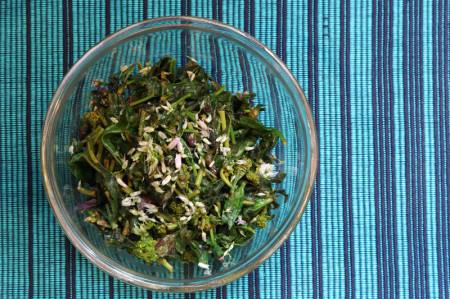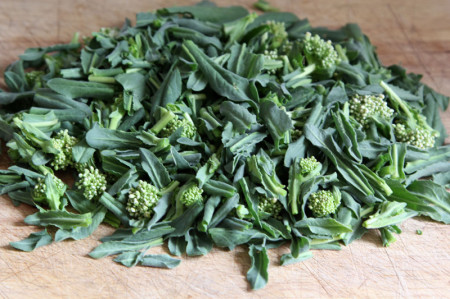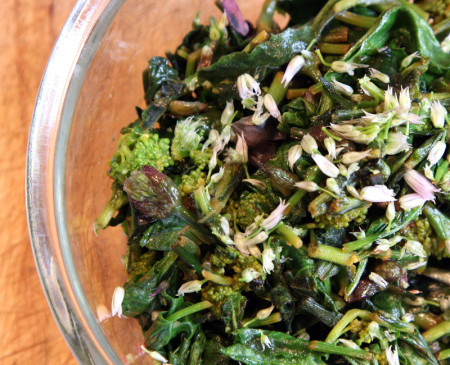
A simple plate of wilted greens, kissed with fresh-squeezed lemon juice and a dash of sweet wine—doesn’t that sound wonderful? I daresay this one came out just right, judged a winner not only by my taste buds but the better half’s astonished declaration: “These are gourmet,” he enthused, his surprise only thinly veiled.
Whereas in the past I have often kept my various wild-foraged veggies separate so as to bring out each one’s individual flavor, here I think I nailed a good combination of strong-flavored wild greens.
First, I used chive flowers and buds. Chive flowers aren’t exactly wild, but in my book, feral, garden-escaped chives (Allium schoenoprasum) are as much a score as native wild onions and garlics. They certainly might be more sustainable. I figure if you can get your hands on some escaped chives, you might as well grab them and call it “foraging.” That’s what I did—except the chives in question had not actually succeeded in becoming feral, due to the pruning efforts of Gregg’s step-dad Jim. The chives used in this recipe, therefore, were rescue-foraged from Jim’s garden, where their budding and flowering tops were soon to go the way of the weeds in the compost bin. I figure they make good practice for wild cookery anyway, since the flowers are so unique. And, this way, when the chives come up of their own accord at the historic site down the street, I’ll be ready. I imagine you could substitute the flowers, buds, or other parts of a variety of wild onions/garlic/leeks (Allium spp.) for equally good results.

The second strong-flavored green I used was invasive hoary cress or whitetop—one of many, many edible wild mustards you might consider using. The young flower bud tops are like loose broccoli, and I chopped the attached stem tops and leaves into approximately 1/3-inch pieces. Whitetop (Cardaria draba syn. Lepidium draba) can be quite spicy fresh, but mellows with cooking. Still, it has a full, mustardy flavor that complemented the chives nicely. Again, I think there are plenty of wild mustards that would do well in this sauté. Just not pennycress.
Last, I used orache (Atriplex sp.) the salty wild spinach that has been the subject of so many of my recent ruminations. Its arrowhead-shaped leaves suck salt from saline soils, eliminating the need for the extra condiment. You could probably substitute wild spinach or lambs’ quarters (Chenopodium album and related), along with a pinch of salt.
Spring Snowstorm
Yesterday afternoon I walked the two dogs we are sitting—a curious Siberian husky with one blue eye and one brown, and a thick old Malamute—up the mountain, in and out of snow squalls alternating with bright sun and blue sky. Everybody loved the walk. The dogs were rolling in the snow and I was beyond happy to be out and breathing mountain air and moving limbs through time and space. I guess the energy translated itself into these yummy wild greens, which tonight, despite the snow on the air, still felt like a celebration of spring.
“Have you been eating chive flowers again?” Gregg asked when he limped through the door to find me buzzing around the kitchen. Somehow, that guy always knows. Just as Nancy does when Jim comes back from tending his garden.

Wilted Wild Greens with Lemon &
Chive Flower Buds
Ingredients:
½ cup chive flower heads, whole
2 cups orache
1 cup wild mustard greens & buds
2 pats of butter
Olive oil
1 tbsp lemon juice
1 tbsp sweet white wine (I used mirin.)
Instructions:
- Sauté whole chive buds, flower heads, and attached stem bits in butter over medium heat until they start to sear.
- Add chopped mustard greens, unopened buds, and soft stems along with enough olive oil to coat and a splash of water. I used hoary cress or whitetop mustard greens.
- After the greens start to wilt, add orache, lemon juice, and sweet wine and sauté until just cooked.
- Serve garnished with broken-apart chive flowers.

NOTE: Whitetop or hoary cress is a pernicious invasive species that takes over gardens and fields. Thus it is a good idea not to spread seeds to new locations. Collect buds before they open. Dispose of flowering parts in a thick garbage bag rather than on the mulch pile. Clean shoes/pants of seeds after walking through a patch before journeying to the next location. But otherwise, feel free to eat this invasive without fear of harming populations. Also, at least one, albeit somewhat dubious, concern has been expressed about the plant’s edibility. See Whitetop–a Wild Invasive Substitute for Broccoli for that discussion. Aside from a field taste test and a handful of flowers here and there, I have to date only consumed whitetop, in quantity, cooked.
MORE INFO:
- Wild Mustard as Broccoli Rabe – By Hunger & Thirst
- Lepidum draba study – By Hunger & Thirst
- Whitetop–a Wild Invasive Substitute for Broccoli – By WFG
- More Whitetop Kitchen Experiments – By WFG

If you come upon more chive flowers, you can use them to make a tasty pink infused vinegar.